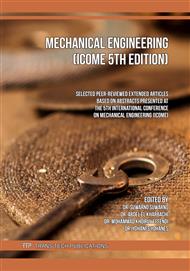p.29
p.39
p.49
p.61
p.67
p.75
p.81
p.89
p.95
Synthesis Analysis to Improve Coupling Strength of Automatic Coupler
Abstract:
In the design of critical components for railways, especially couplers, it is necessary to pay attention to the strength of the coupling between the couplers with each other. Coupling failure can have fatal consequences in the form of the train series being detached when operating. This study aims to improve the coupling strengthening of coupler prototype that meet international standard. The study begins with the calculation of longitudinal train force on light trains to obtain a coupler force followed by kinematics analysis on the initial coupler design to be improved using dimensional synthesis in the form of path generation and motion generation. Failsafe device design is done as an effort to strengthen the coupling. At the final stage, design verification is carried out in the form of structural strength analysis to compare the initial design with the new design. From the simulation results, it is found that the new design with a parallelogram configuration with 25° slope angle has a stronger coupling than the previous design. In addition, the addition of a failsafe device also plays a role in increasing the coupling strength of the coupler.
Info:
Periodical:
Pages:
67-73
Citation:
Online since:
March 2023
Authors:
Keywords:
Price:
Сopyright:
© 2023 Trans Tech Publications Ltd. All Rights Reserved
Share:
Citation:



